Last updated: November 16, 2023
Article
Rationing of Non-Food Items on the World War II Home Front
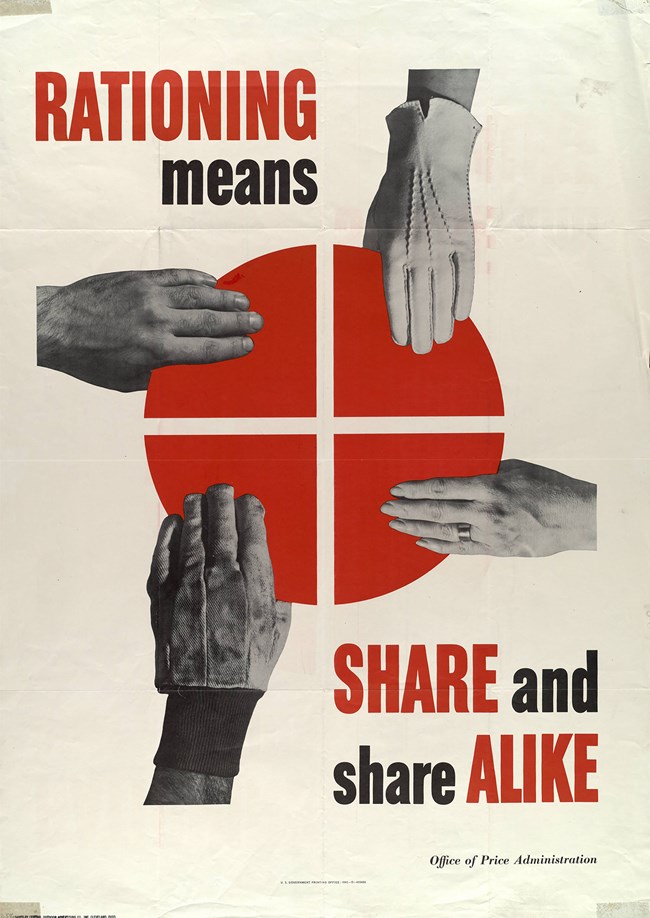
Collection of the Hennepin County Library, Minnesota (MPW00223).
Rationing was overseen by the federal Office of Price Administration (OPA), assisted by information from other wartime agencies. Using their nation-wide overview of supply, demand, and the economy, the OPA dictated which items to ration, set ceiling prices, and allocated available supply.
These limits both ensured a fair distribution of goods and helped to keep inflation in check. Rationing was managed at the local level by volunteer rationing boards. By the end of the war, over 100,000 citizen volunteers were managing the program organized into about 5,600 local boards.[1]
Rationed non-food items included tires, cars, bicycles, gasoline, fuel oil and kerosene, solid fuels (like coal), stoves, footwear, and typewriters (information on the rationing systems for food are written separately). To buy these items, consumers had to present both the appropriate paperwork and the money to pay for the item.
Tires, Bicycles, and Gasoline
The rationing of these commodities was largely to preserve rubber for the war effort. (Many other rubber-based products like hoses and raincoats were not rationed, they simply disappeared from shops.) Before the war, the United States had built up a stockpile of crude rubber, but it was only enough for a single year in peacetime. And although researchers (including Japanese scientists at Manzanar) were working on alternative sources, the technology was not advanced enough to supply both the military and civilians.[2]
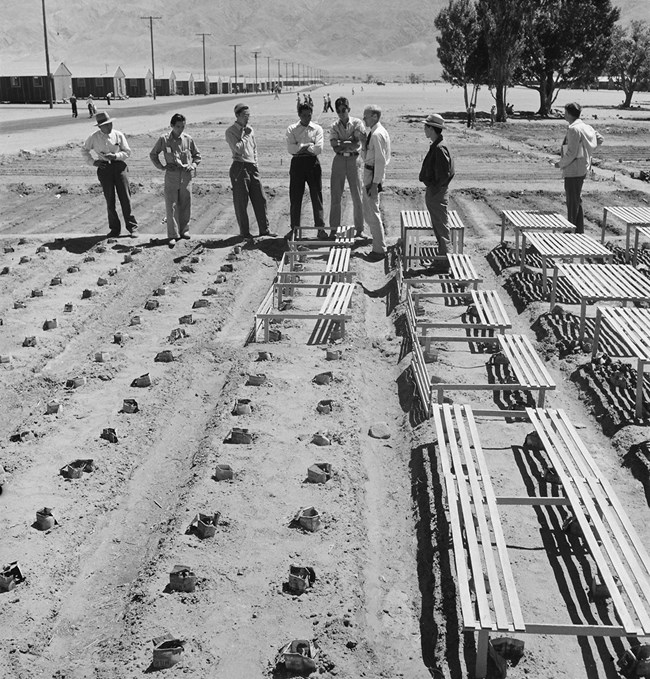
Collection of the National Archives and Records Administration (538018).
Working with Robert A. Emerson from the California Institute of Technology, Japanese American scientists at Manzanar developed a sustainable, natural source of rubber using Guayule. Guayule is a small, woody, drought-resistant shrub that looks like sagebrush.
For the team, this was a chance to show that many of the Japanese Americans being forcibly incarcerated were, in fact, patriotic. Emerson paid for much of the equipment out of his own pocket.
To add to the project's glassware supply, those at Manzanar ate a lot of peanut butter and jam, donating the empty jars to the cause. Researchers also repurposed equipment like milkshake blenders and washing machines.
Guayule rubber from Manzanar was much stronger than that developed by other teams working outside the camp. It was also at least as strong as the product made from the rubber tree.
Despite its success, the Manzanar project was not allowed to continue after the camp was closed. In fact, the lab equipment and surviving plants were destroyed. Members of the research team were convinced that big oil stopped the program to protect their synthetic rubber business.[3]
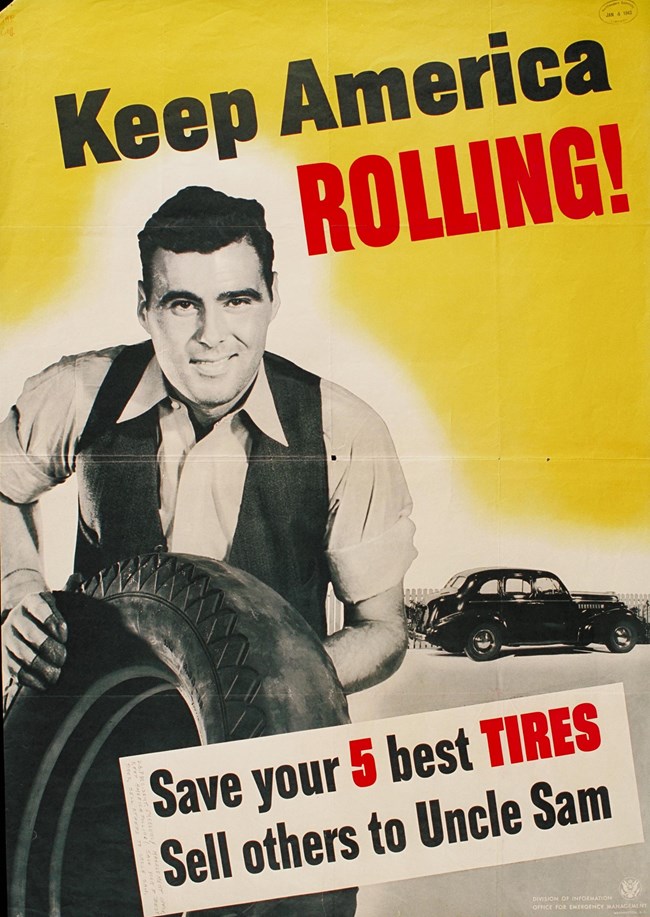
Collection of Northwestern University Libraries (ark:/81985/n2x923k0g).
Tires
Three quarters of rubber in the US was used for car tires. In wartime, however, rubber was needed for military vehicles, boots, gas masks, and rain coats, among other items. A single battleship required over 75 tons of rubber.[4] The government stopped the sale of tires in mid-December 1941, and rationing began January 5, 1942. Tires were the first item rationed, and remained rationed through the end of December 1945.[5]
Civilians were allowed to keep 5 tires – four on their passenger vehicle, and one spare. The rest had to be surrendered. Good tires were so scarce that the government recommended recording their serial numbers in case they were stolen.
Replacement tires were available only through application to the local rationing boards. They issued certificates to those whose vehicles met the qualifications. These included: public transportation; transportation of food and fuel; garbage trucks; and for public safety like ambulances, fire trucks, and police cars.
The rationing board could also issue certificates for retreading tires, also known as recapping. This process attached new tread to an old tire, extending its life.[6] These days, tires regularly last 50,000 miles or more. But tires in the World War II era lasted a mere two years under normal usage. Blowouts and flats were common, making life with rationed tires even more difficult.[7]
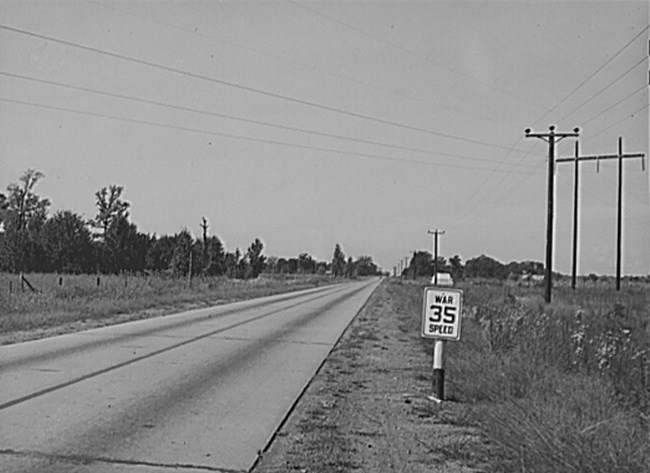
Collection of the Library of Congress (https://lccn.loc.gov/2017838371).
The federal rationing of gasoline was largely to reduce wear on tires, as was the “Victory Speed” of 35 miles per hour (tires wore out twice as fast at 60 miles per hour than at 35).[8] Tires were inspected twice a week or more – sometimes by employers -- to ensure proper tire pressure (a tire rated at 30 pounds of pressure wore through 21% more rubber at 27 pounds and cut its lifetime in half at 21 pounds).[9]
Bicycles
The government rationed bicycles from July 1942 to September 1945. The goal was to reduce the amount of wartime materials used for bicycles, but also to ensure that those who rode instead of drove could get one (thereby saving on car tires and gasoline).[10]
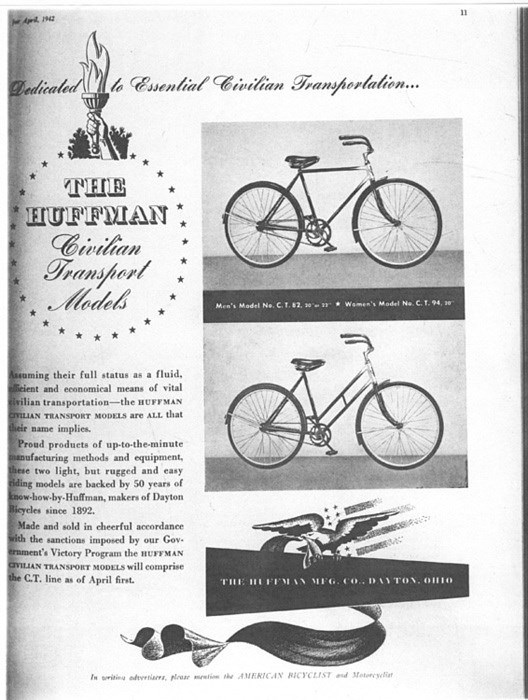
Collections of the National Museum of American History (https://americanhistory.si.edu/collections/search/object/nmah_1313316).
Shortly after the December 1941 Japanese attacks, the government took over control of the bicycle industry. They halted the bicycle trade entirely, and forbade bicycles from leaving “a factory, a jobber, a wholesaler, or a retailer’s place of business after 11:59 tonight” (April 3, 1942). They hoped this would prevent hoarding, and also gave them the opportunity to evaluate supply and demand.[11]
The government issued specifications for what became known as Victory bicycles. These were designed and built only for adults; bikes for children were not manufactured during the war. Victory bikes were lightweight, weighing no more than 31 pounds (lighter by about a third than pre-war). They were made of steel only with no copper or nickel parts, and a minimum of chrome plating. Paint was used instead on handlebars and wheel rims. Accessories like chain guards, bells, and whitewall tires were removed, and a maximum tire width of 1-3/8" was set.[12] Behind the scenes, there were disagreements between the OPA and the Wartime Production Board (WPB) about the necessity of bicycle rationing – were bicycles a luxury? Was the rubber needed to make bicycle tires better used for other war needs while people continued to put wear on the car tires they already owned? This debate was eventually resolved, and Victory bikes went into production.[13]
When rationing began in July 1942, the OPA had 150,000 Victory bicycles and 90,000 pre-war bicycles to divide up. To get a bicycle, you had to apply at the local rationing board and prove you needed a bicycle. For example, your job was too far to walk to, and there was no good public transportation. By August 1942, access to bicycles was further limited to health care workers, school teachers, fire fighters, and others in critical occupations. New and used bicycles became much in demand, as thousands used them to get to their war jobs.[14] Despite this, the numbers of bicycles made and allocated by rationing boards never met the actual demand.[15]
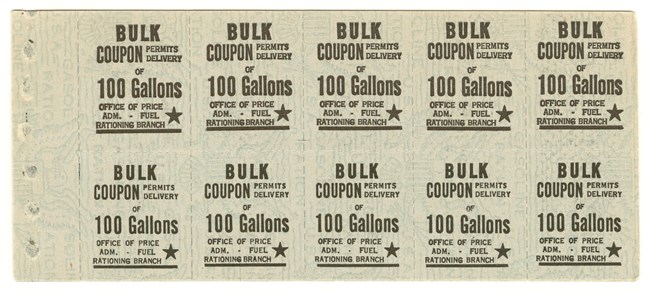
Collection David M. Rubenstein Rare Book & Manuscript Library, Duke University (ark:/87924/r3tx35h0g).
Gasoline
Gasoline rationing began on the East coast in mid-May 1942. Enemy submarines had been targeting and sinking the tankers bringing it from the Gulf of Mexico. Rationing gave the government time to establish overland delivery systems including rail cars, tanker trucks, barges, and new pipelines. Nation-wide gasoline rationing began in December of 1942 to limit the amount of gasoline used by civilians, but also to save wear on tires. Gas stations and commercial users also had their gasoline rationed. There are news reports of drivers following gasoline delivery trucks to gas stations and lining up for miles to fill their cars the day before gasoline rationing went into effect.[16]
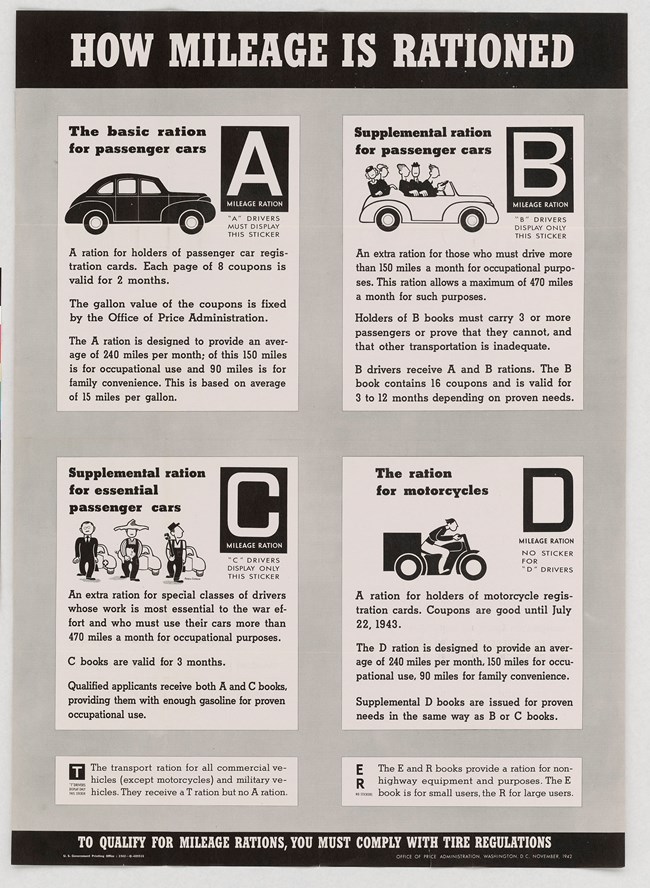
Collection of the National Archives and Records Administration (NAID: 514538).
Gasoline rations were based on need. Every car had to have a sticker in its front windshield showing how much fuel the driver was allowed (these amounts shifted slightly throughout the war, depending on supply and demand). Ration stamps with the same letter were required when purchasing gasoline. There were several different types of sticker, each with a letter. For example, “A” stickers went to most drivers, allowing 2-4 gallons of gasoline per week; “B” stickers allowed 8-10 gallons per week for those who commuted long distances to work and who carried 3 or more passengers; “C” stickers allowed unlimited gasoline for those with certain critical jobs including doctors, mail carriers, telegram delivery, etc. There were also different rations and stickers for motorcycles, emergency vehicles, farm vehicles, and commercial trucks. The “X” sticker, which had no limit on how much gasoline could be purchased, was issued to VIPs, including (controversially) several congress members. On the reverse of each sticker were printed reminders to drive under 35 miles per hour; to share the car; to check tire pressure; to stop, start, and turn slowly; to rotate tires; and to consider whether the trip was really necessary.[17]
At the gas station, attendants checked the sticker on the windshield, making sure that it and the license plate matched the buyers' ration stamps. After these and other checks were complete, attendants detached the correct number of ration stamps and took payment for the gasoline.[18]
It was possible to lose access to rationed gasoline. Those who kept more than the 5 tires allowed by the government could not get their rations until they surrendered the extras. People who sped, went on joy rides, or misused the gasoline rationing system forfeited their rations. In several cities, night courts were set up to handle the number of people who disobeyed the pleasure driving regulations. Gasoline rationing ended in August 1945.[19]
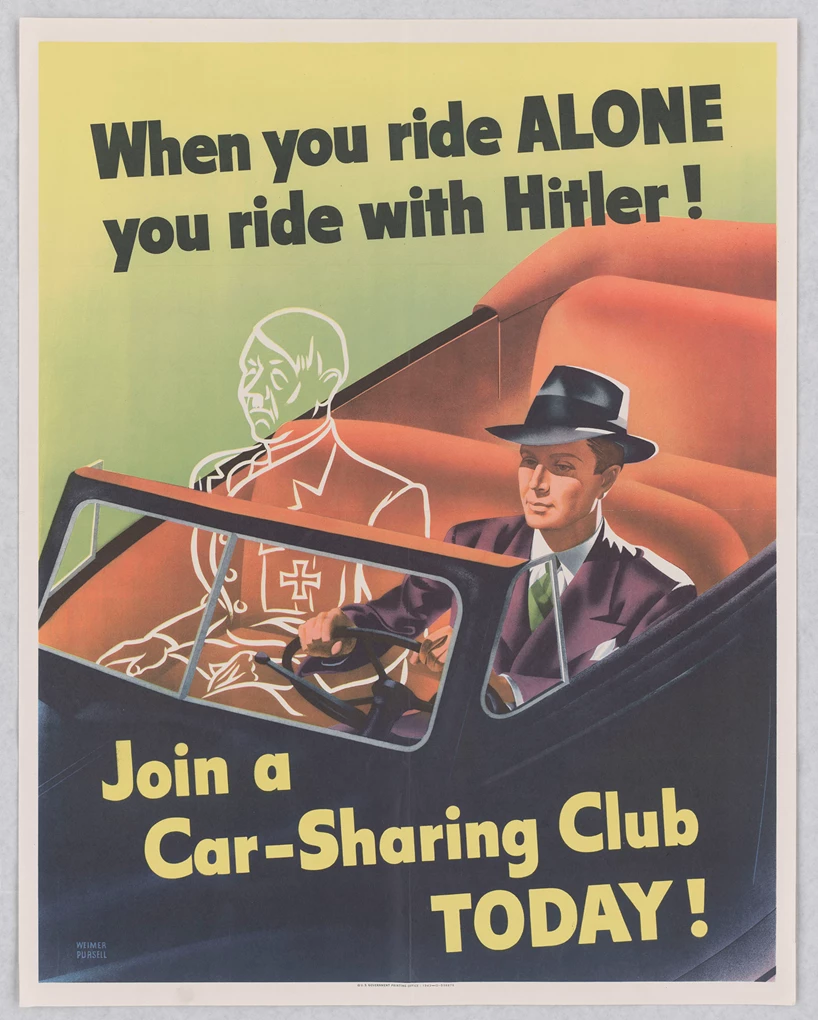
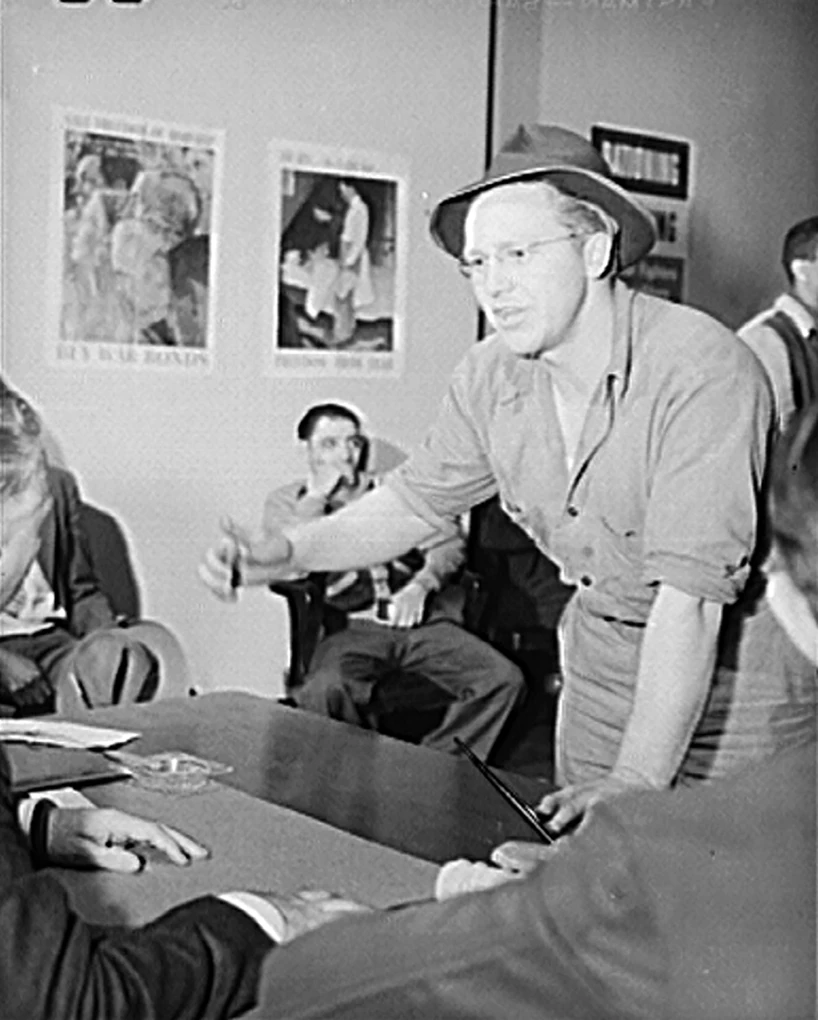
Left image
“When you ride alone, you ride with Hitler! Join a Car-Sharing Club Today!” This poster encourages people to carpool and share their car with others. US Government Printing Office, 1943.
Credit: Collection of the National Archives and Records Administration (NAID: 516143).
Right image
The OPA held nightly hearings for violators of the pleasure driving rules. This man in Pittsburgh, PA is mad because his gas ration book was taken away. He was caught driving to a baseball game. Photo by Marjory Collins, Office of War Information, 1943.
Credit: Collection of the Library of Congress (https://lccn.loc.gov/2017856171).
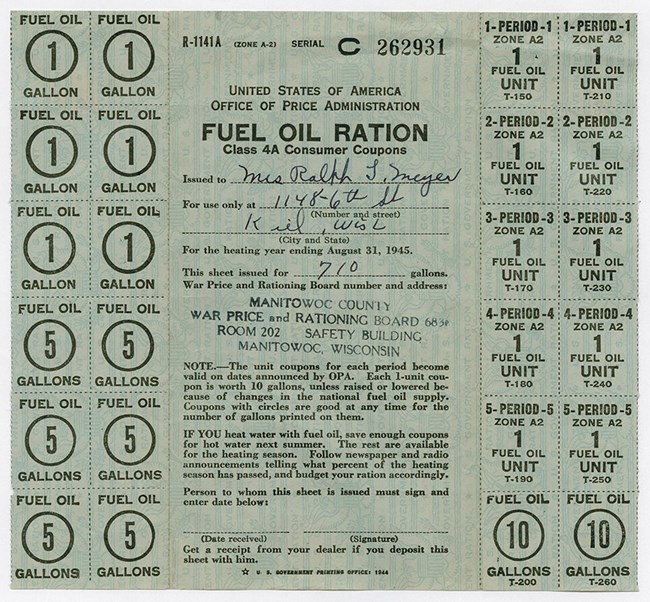
Collection of the Edwin Majkrzak Historical Research Center, Kiel Public Library (https://digital.library.wisc.edu/1711.dl/NUENAAUXVCV3W8L).
Fuel Oil, Kerosene, and Solid Fuels
Fuel oil, kerosene, and solid fuels were used for home heating, lighting, hot water, cooking, and other necessities, as well as commercial and agricultural uses. Rations were allocated by need – for example, those in colder parts of the country needed more heating fuel than those who were not.
One poster from 1945 announces that “All fuel is scarce, plan for winter now!” and encourages people to make sure their heating system is working and to order fuel at once. It also urges people to winterize their home -- a word that most Americans would not have been familiar with.[20]
Fuel Oil and Kerosene
Fuel oil and kerosene were rationed from October 1942 through August 1945.[21] These fuels included range oil, coal oil, stove oil, lamp oil, tractor fuel other than diesel, furnace oil and diesel.[22]
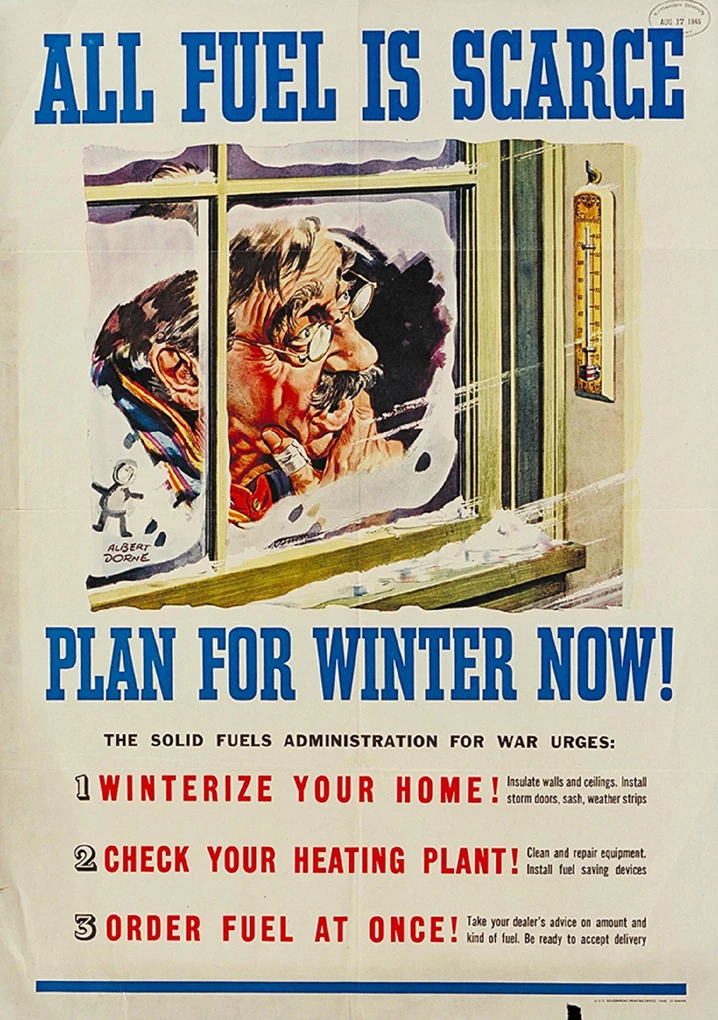
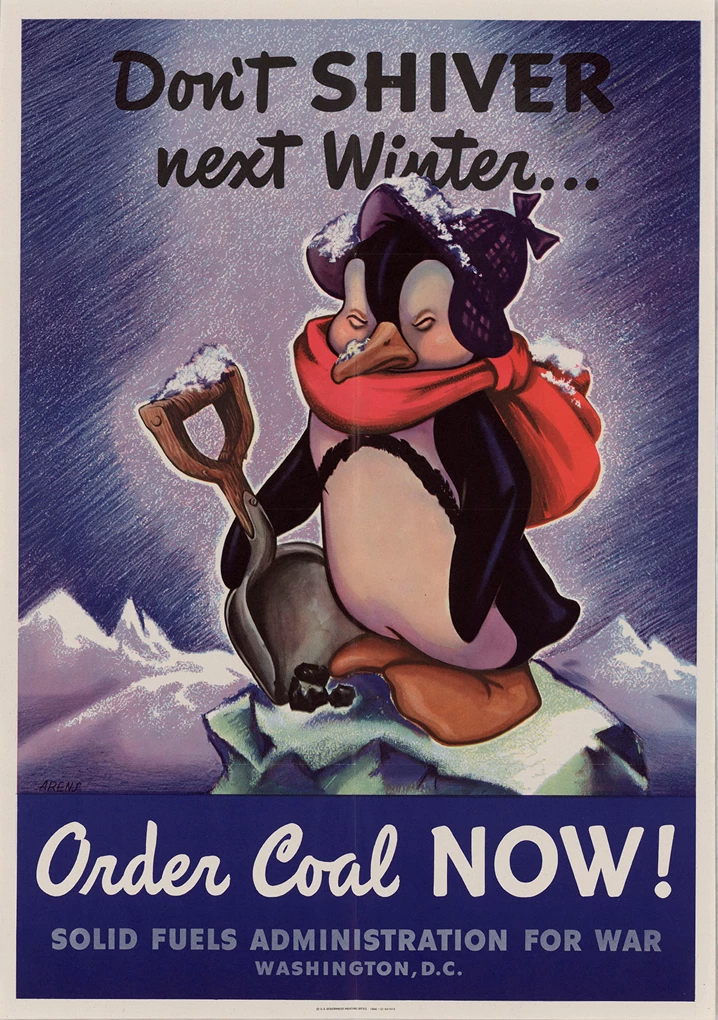
Left image
“All fuel is scarce. Plan for winter Now!” This poster urges people to winterize their homes; to check their heat source; and order fuel at once. Solid Fuels Administration, 1945.
Credit: Collection of Northwestern University Libraries (ark:/81985/n2q816t1r).
Right image
“Don’t SHIVER next Winter… Order Coal NOW!” poster. Solid Fuels Administration for War, 1944.
Credit: Collection of the National Archives and Records Administration (NAID: 514163).
Solid Fuels
Solid fuels (various types of coal including anthracite and bituminous coals and processed fuels like briquettes) were rationed from September 1943 to August 1945.[23] Much of the shortage of solid fuels was at the supply end. When young miners left to join the military, they left older men and men not eligible to serve in the military because of a 4-F certification (unfit for military service due to physical, mental, or moral reasons) to carry on the work. Unlike in other wartime jobs, women did not replace men in the mines, in part because miners considered it bad luck. Women in the mines were believed to bring disaster like an accident or cave-in.[24]
A larger issue, however, was a labor dispute between the United Mine Workers of America and the mine owners in early 1943. Unable to reach an agreement as their previous contract expired, workers across the coal industry went on strike April 1, 1943. One of their key demands was for portal-to-portal pay. This meant that they would get paid for the full number of hours they were on mine property, not just the time they were down in the mine.[25]
When no solution to the strike was forthcoming, the Coal Mines Administration (led by Secretary of the Interior Harold L. Ickes) seized the mines on May 1, 1943. The Administration appointed existing mine managers to continue operations. Mines were returned to former owners as labor conflicts lessened, but then re-seized and re-returned as labor unrest continued. By June 1944, the disputes had ended. Mine workers won back payment for portal-to-portal work as well as portal-to-portal pay moving forward.[26]
Unlike other goods that were easily stockpiled, coal was bulky, and could not be stored at the mines until it was needed.[27] To help solve the storage issue and ensure that enough coal was available, consumers were urged to apply for and purchase their winter coal early. Like other rationed goods, maximum prices for solid fuels were set by the government. The goal was for consumers to receive up to 90% of their previous year’s amount, distributed (as much as possible) in equal monthly shipments.[28]
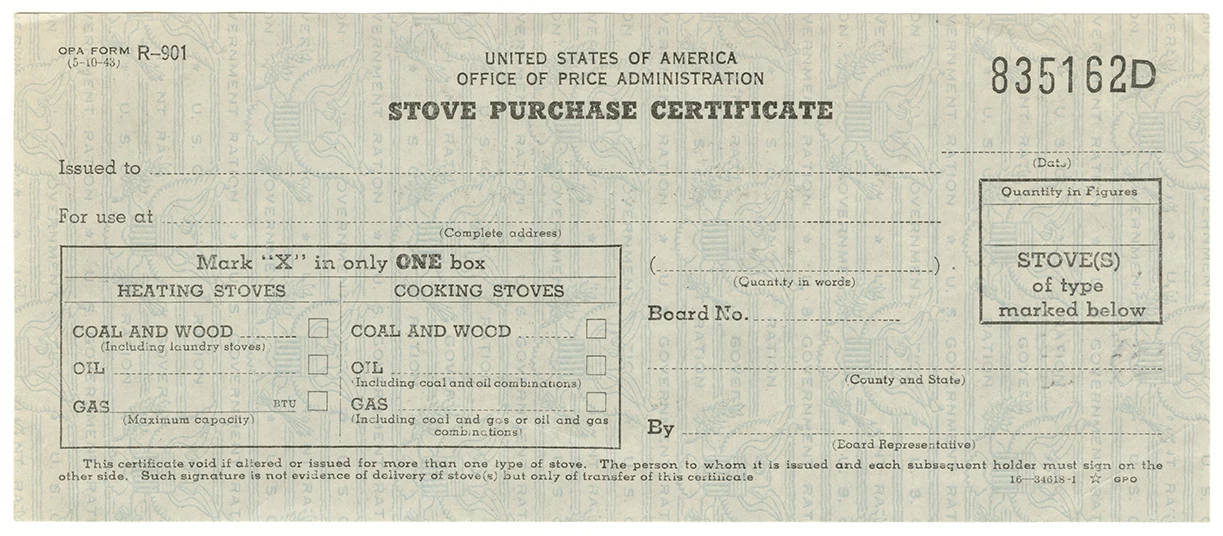
Collection of the David M. Rubenstein Rare Book & Manuscript Library, Duke University Libraries (ark:/87924/r3w08ws3d).
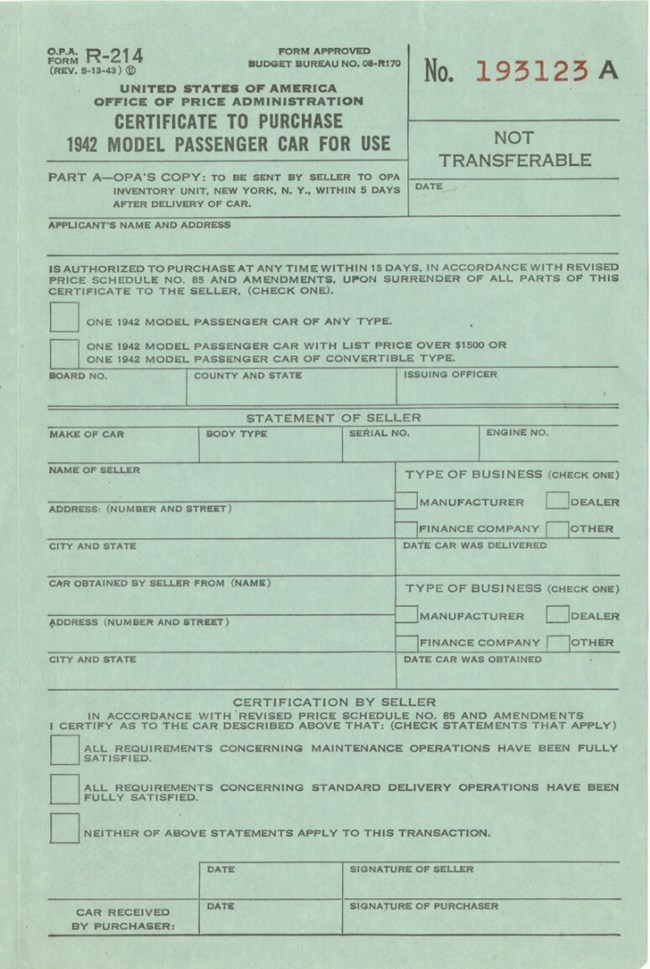
Collection of the David M. Rubenstein Rare Book & Manuscript Library, Duke University Libraries (ark:/87924/r3d21rv1c).
Stoves and Cars
Both stoves and cars were rationed so that their materials (largely steel) and production capacity could go to the war effort.
Stoves
Heating and cooking stoves were rationed from December 1942 to August 1945.[29] In order to get a new one, you had to apply to the local ration board for a purchase certificate.
Cars
Cars were rationed between February 1942 and October 1945. An analysis of the number of cars versus the number of people in the US in 1941 reveals about 88 percent of American households had at least one car.[30]
In February 1942, the government ceased the manufacture and sale of all civilian vehicles, and stockpiled the rest to be rationed. All automobile production capacity went to the war effort, manufacturing military vehicles from cars to airplanes.
To get a car, you had to apply to your local rationing board for a purchase certificate. Necessary workers like police, doctors, and farmers were eligible, but still had to show that they had an older car with more than 40,000 miles on it.[31]
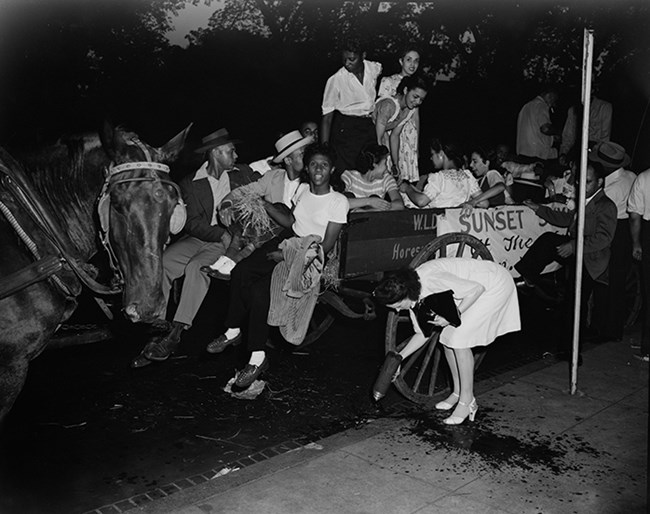
Collection of the Library of Congress (https://lccn.loc.gov/2017860002).
Most Americans had to make do with the car they had at the start of the war (though some switched to horse power). Some were able to keep their vehicles limping along despite a shortage of parts. Some people, in fact, took pride in how run down their car could be and still run.
Not only was it increasingly difficult to keep cars running, but beginning in February 1942 the government imposed a Wartime Motor Vehicle Use tax. Every month, drivers had to buy a new tax stamp costing as much as $5 (roughly equivalent to $76 in 2023).
Many people just stopped driving. The number of households with cars dropped to about 73% by 1945. Instead, people carpooled, used public transportation, or bicycled. Some even bought cars together, sharing access and costs. This set the stage for a great consumer hunger for cars once the war ended.[32]
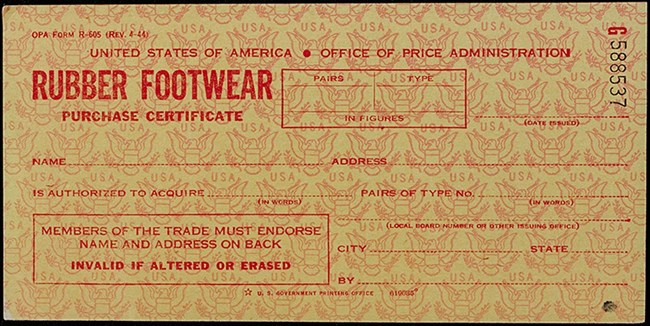
Collection of Northwestern University Libraries (ark:/81985/n2d797b7p).
Shoes and Boots
Rubber boots were rationed as early as October 1942 to save on rubber usage. On February 7, 1943, with only a couple of days’ notice, leather footwear joined the ration list.[33] Both leather and rubber from shoe soles was needed for the war. As well as rationing shoe quantity, the OPA limited the colors of shoes available. Only black, white, “town brown,” and “army russet” could be made and sold. Two-toned shoes were prohibited, as were boots taller than 10 inches and heels thicker than 2-5/8 inches. All non-essential frills and trimmings, men’s sandals, house slippers, running shoes, and golf shoes vanished from the market. Shoes and boots remained rationed until October 1945.[34]
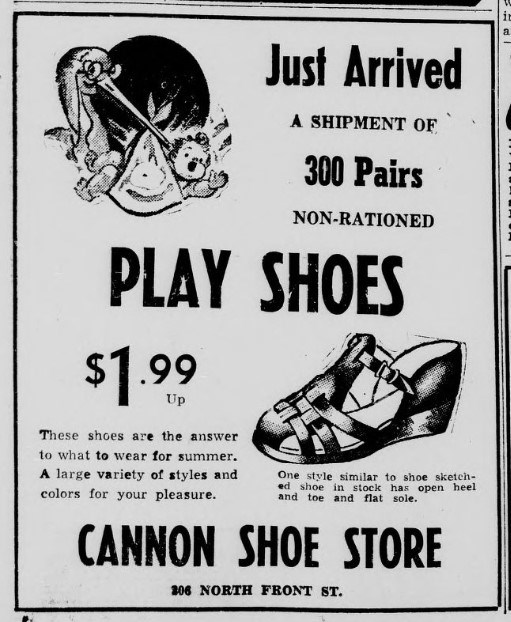
Wilmington Morning Star, July 23, 1943, p. 6. From the Chronicling America collection at the Library of Congress.
Each person received three shoe coupons per year in 1943. This was reduced to two pairs of shoes in March of 1944 because of shortages of leather. Those who needed footwear for work, like mail carriers, and those who were pregnant or needed medical shoes could get additional pairs.
You could also apply to your local rationing board for a purchase certificate if your shoes were destroyed in a fire or flood or stolen. These applications were long, and required listing all of the shoes you owned and explaining why a replacement was necessary.[35] Those who could not get extra pairs had to made do with what they had. Beginning in 1943, the quality of shoe repairs increased when the government allowed cobblers to buy old stock and single shoes to use for repairs.[36]
Those with children in their lives know that their feet can grow really quickly. But children were also bound by the ration limit on shoes. To ensure that they had shoes, adults would cut back on their ration allowance and share their saved coupons with family and friends who needed them.[37]
Not all shoes were rationed. Second-hand or manufacturer’s seconds did not require a ration coupon. Neither did shoes made from non-rationed materials, including plastic, small amounts of reclaimed rubber, cardboard, fabric, and reclaimed fire hose. The demand for these unrationed “synthetic” shoes was so great in 1943 that manufacturers could not meet it. Many limited the quantities available, and supplied their better customers first.[38]
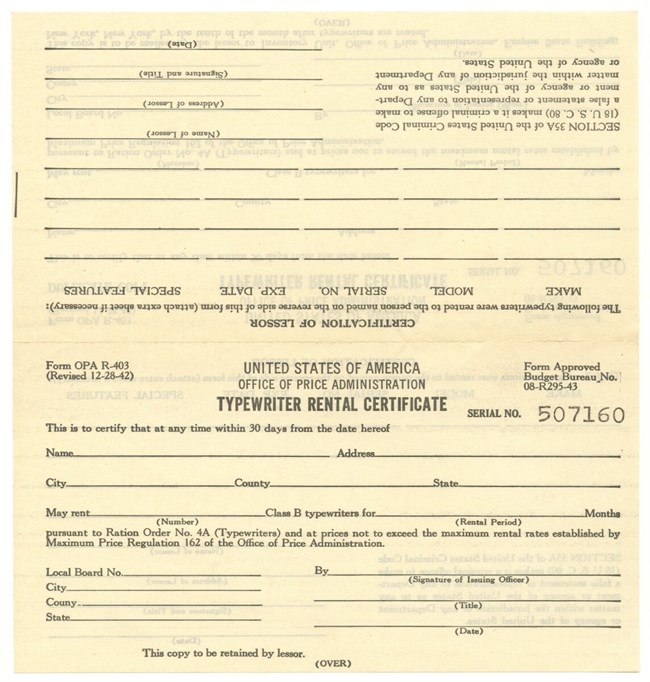
Collection of the David M. Rubenstein Rare Book & Manuscript Library, Duke University Libraries (ark:/87924/r3v40k86f).
Typewriters
Typewriters were rationed from March 1942 through April 1944. [39] The metal they were made from, like the metal from so many other items, was needed for the war effort. Perhaps even more in demand were the machines themselves. Wartime meant massive amounts of paperwork, and clerks and others needed typewriters to do their work. Civilians were asked to donate their working, nonessential typewriters to the war effort. Those who needed a typewriter had to apply to rent one from government stockpiles via their local ration board.[40]
Despite the best efforts of the government, the volunteer rationing boards, the police, and civilian defense workers, there were many people who found ways to work around the ration system. These included theft, counterfeiting, hoarding, fraud, and organized crime in illicit trade, also called the black market.
This article was written by Megan E. Springate, Assistant Research Professor, Department of Anthropology, University of Maryland, for the NPS Cultural Resources Office of Interpretation and Education. It was funded by the National Council on Public History's cooperative agreement with the National Park Service.
[1] National World War II Museum n.d.
[2] Sundin 2022b; United States Office of Price Administration 1943a: 6, ca. 1943.
[3] Finlay 2011; van Harmelen 2022. Manzanar War Relocation Center was listed on the National Register of Historic Places on July 30, 1976. It was designated a National Historic Landmark on February 4, 1985. It became a unit of the National Park Service as Manzanar National Historic Site on March 3, 1992.
[4] Graff 2022.
[5] Ames History Museum n.d.a; Kennett 1985: 133; Sundin 2022b.
[6] Kennett 1985: 133; National World War II Museum n.d.; Sundin 2022b; United States Office of Price Administration 1943a: 6.
[7] Reed, Lyman 2012; see Mary Ann Reed 2012 for a story about travelers getting two flats, and needing to finish their drive on the rim.
[8] Sundin 2022b.
[9] Graff 2022.
[10] Ames History Museum n.d.a; National Museum of American History n.d.
[11] Longhurst 2020.
[12] National Museum of American History n.d.
[13] Longhurst 2020.
[14] National Museum of American History n.d.
[15] Longhurst 2020.
[16] Tracy 2020.
[17] Ames History Museum n.d.b; Graff 2022; Minnesota Historical Society n.d.; New York Times 1973; Sundin 2022a.
[18] Sundin 2022a; United States Office of Price Administration 1942.
[19] Ames History Museum n.d.a; Graff 2022; United States Office of Civilian Defense 1942a, 1942b; United States Office of Price Administration 1943b.
[20] Anchor n.d.
[21] Ames History Museum n.d.a.
[22] Thaddeus B. Hurd Digital Archive 2010.
[23] Ames History Museum n.d.a.
[24] Fishman and Fishman 1952: 393, 395; Freytag 1945: 257-268, 280; Miller 2013. Women did not find ready employment in mines until after 1972. In 1965, President Johnson signed an executive order that said coal companies with federal contracts could not discriminate in employment due to sex or race. But it was not until President Nixon signed the Equal Employment Opportunity Act of 1972 that women found success in filing discrimination charges against mining companies who refused to hire them (Armstrong 2022; see also Beazley 1979 and Miller 2013).
[25] Freytag 1945: 269-270; Messitte and Wolfe 1944: 142.
[26] Freytag 1945: 269-270.
[27] Messitte and Wolfe 1944: 143.
[28] Fretag 1945: 272-273; Messitte and Wolfe 1944: 146.
[29] Ames History Museum n.d.a.
[30] Ames History Museum n.d.a; Tang 2023. The calculation of the number of cars per household is based on the assumption of four people per household (i.e. a nuclear family of two parents and two children). An examination of the number of cars per person in the US in 1941 shows just over 22% of individuals having a car.
[31] Graff 2022.
[32] Graff 2022; Mary Ann Reed 2012. The Wartime Motor Vehicle Use Tax program stayed in effect even after the war ended. It was finally repealed in June 1946.
[33] Ames History Museum n.d.a; Cherry 2023.
[34] Ames History Museum n.d.a; FOTO Staff 2018; United States Office of Price Administration 1943a: 4. House slippers with 15% or less of reclaimed rubber in their soles were taken off the ration list in 1943.
[35] Cherry 2023; FOTO Staff 2018; Sundin 2023.
[36] United States Office of Price Administration 1943a: 4.
[37] Mary Ann Reed 2012; Sundin 2023.
[38] FOTO Staff 2018; New York Times 1943; Sundin 2023; United States Office of Price Administration 1943a: 4; Uzzell 2012.
[39] Ames History Museum n.d.a.
[40] Blumenthal 2014; Sundin 2011.
[41] Text from the Gas Rationing Poster Image: “A. The basic ration for passenger cars. A drivers must display this sticker. A ration for holders of passenger car registration cards. Each page of 8 coupons is valid for 2 months. The gallon value of the coupons is fixed by the Office of Price Administration. The A ration is designed to provide an average of 240 miles per month; of this 150 miles is for occupational use and 90 miles is for family convenience. This is based on average of 15 miles per gallon. B. Supplemental ration for passenger cars. B drivers display only this sticker. An extra ration for those who must drive more than 150 miles a month for occupational purposes. This ration allows a maximum of 470 miles a month for such purposes. Holders of B books must carry 3 or more passengers or prove that they cannot, and that other transportation is inadequate. B drivers receive A and B rations. The B book contains 16 coupons and is valid for 3 to 12 months depending on proven needs. C. Supplemental ration for essential passenger cars. C drivers display only this sticker. An extra ration for special classes of drivers whose work is most essential to the war effort and who must use their cars more than 470 miles a month for occupational purposes. C books are valid for 3 months. Qualified applicants receive both A and C books, providing them with enough gasoline for proven occupational use. D. The ration for motorcycles. No sticker for D drivers. A ration for holders of motorcycle registration cards. Coupons are good until July 22, 1943. The D ration is designed to provide an average of 240 miles per month. 150 miles for occupational use. 90 miles for family convenience. Supplemental D books are issued for proven needs in the same way as B or C books. T. The transport ration for all commercial vehicles (except motorcycles) and military vehicles. They receive a T ration but no A ration. T drivers display only this sticker. E and R (no stickers). The E and R books provide a ration for non-highway equipment and purposes. The E book is for small users, the R for large users. TO QUALIFY FOR MILEAGE RATIONS, YOU MUST COMPLY WITH TIRE REGULATIONS.”
Ames History Museum (n.d.a) “Rationed Goods in the U.S. During World War II.” Ames History Museum.
--- (n.d.b) “World War II Rationing on the U.S. Homefront.” Ames History Museum.
Anchor (n.d.) “All fuel is scarce – plan for winter now!” Anchor: A North Carolina History Online Resource.
Armstrong, Holly (2022) “A Brief History of Women in Mining.” US Department of Labor Blog, March 22, 2022.
Beazley, Ernie (1979) “Champion of the Woman Miner.” New York Times, October 7, 1979, Section F, p. 7.
Blumenthal, Ralph (2014) “Buddy, Can You Spare A Typewriter?” An Adventure in Democracy: The Institute of Public Administration Collection: A Processing Blog, September 24, 2014.
Cherry, Dan (2023) “Lenawee County History: World War II Shoe Rationing Implemented 80 Years Ago Today.” LenConnect.com/Daily Telegram February 7, 2023.
Finlay, Mark R. (2011) “Behind the Barbed Wire of Manzanar: Guayule and the Search for Natural Rubber.” Distillations, Science History Institute, November 2, 2011.
Fishman, Leo and Betty G. Fishman (1952) “Bituminous Coal Production During World War II.” Southern Economic Journal 18(3): 391-396.
FOTO Staff (2018) “These Photos Captured What Happened When the United States Started to Ration Does During WWII.” Smithsonian Magazine, March 8, 2018.
Freytag, R.C. (1945) “The Indiana Coal Industry’s Part in World War II.” Indiana Magazine of History 41(3): 265-286.
Graff, Cory (2022) “Making Automobiles Last During World War II.” National World War II Museum, January 6, 2022.
Kennett, Lee (1985) For the Duration... : The United States Goes to War, Pearl Harbor-1942. Scribner, New York.
Longhurst, James (2020) “Reconsidering the Victory Bike in WWII.” Bike Battles, March 25, 2020. (online version of James Longhurst (2018) “Reconsidering the Victory Bike in World War II: Federal Transportation Policy, History, and Bicycle Commuting in America.” Transportation Research Record, 2672(13): 29-37.)
Messitte, Jesse B. and Robert Wolfe (1944) “The Solid Fuels Administration for War and Industry Advisory Groups.” Dickinson Law Review 48(3): 141-154.
Miller, Carl (2013) “Miners’ Superstitions Are Eventually Overcome.” Leadville Herald Democrat, June 19, 2013.
Minnesota Historical Society (n.d.) “Minnesota’s Greatest Generation: Gasoline Ration Card and Stamps.” Minnesota Historical Society.
National Museum of American History (n.d.) “1942 Victory Bicycle.” National Museum of American History.
National World War II Museum (n.d.) “Rationing.” National World War II Museum.
New York Times (1973) “The ABC’s of Gas Rations.” New York Times, November 13, 1973, p. 61.
--- (1943) “Unrationed Shoes Wanted for Spring.” New York Times, October 19, 1943, p. 30.
Reed, Lyman (2012) “Texas City / World War II Oral History Project Audited Transcript: Lyman Reed Interviewed by Vivi Hoang, June 12, 2012.” Moore Memorial Public Library.
Reed, Mary Anne (2012) “Texas City / World War II Oral History Project Audited Transcript: Mary Anne Reed Interviewed by Vivi Hoang, June 12, 2012.” Moore Memorial Public Library,
Sundin, Sarah (2023) “Make It Do: Shoe Rationing in World War II.” Today in World War II History, February 6, 2023.
--- (2022a) “Make It Do: Gasoline Rationing in World War II.” Today in World War II History, July 22, 2022.
--- (2022b) “Make It Do: Tire Rationing in World War II.” Today in World War II History, January 5, 2022.
--- (2011) “Make It Do: Metal Shortages During World War II.” Today in World War II History, July 11, 2011.
Tang, Shuling (2023) Transportation Deployment Casebook/History of the Automobile: Ownership per Household in the US. Wikibooks, March 23, 2023.
Thaddeus B. Hurd Digital Archive (2010) “Fuel Oil Rationing Form R-1175: Supplementary Information Sheet.” Ohio Memory, March 1, 2010.
Tracy, Deb (2020) “Gas Rationing in World War II.” American Car Historian, August 27, 2020.
United States Office of Civilian Defense (1942a) “Speeders to Lose Gas Ration Books. Bulletin No. 400, October 22, 1942.” Los Angeles County Civilian Defense Council Bulletins, Library of Congress.
--- (1942b) “Tires in Excess. Bulletin No. 471, November 23, 1942.” Los Angeles County Civilian Defense Council Bulletins, Library of Congress.
United States Office of Price Administration (1943a) “Rationing and Price Control Script for Mr. Hale, KSLM 9/9/43” [radio script]. Oregon State Archives, Defense Council Records, Folder 9, Box 35. From Life on the Home Front: Oregon Responds to World War II.
--- (1943b) “Facts You Should Know: Gasoline, November 1943.” Oregon State Archives, Defense Council Records, Folder 8, Box 35. From Life on the Home Front: Oregon Responds to World War II.
--- (ca. 1943) “The Consumer and the War: Tire Rationing” [radio script]. Oregon State Archives, Defense Council Records, Folder 9, Box 35. From Life on the Home Front: Oregon Responds to World War II.
--- (1942) “Important to Service Station Attendants” [poster]. Library of Congress.
Uzzell, Gwen Atwood (2012) “Texas City / World War II Oral History Project Audited Transcript: Gwen Atwood Uzzell Interviewed by Vivi Hoang, March 26, 2012.” Moore Memorial Public Library.
Van Harmelen, Jonathan (2022). “Guayule Project.” Densho Encyclopedia, September 12, 2022.
Table of Contents
1. Introduction
2. The American Home Front Before World War II
3. The American Home Front and the Buildup to World War II
3B The Selective Service Act and the Arsenal of Democracy
4. The American Home Front During World War II
4A A Date That Will Live in Infamy
4A(i) Maria Ylagan Orosa
4C Incarceration and Martial Law
4D Rationing, Recycling, and Victory Gardens
4D(i) Restrictions and Rationing on the World War II Home Front
4D(ii) Food Rationing on the World War II Home Front
4D(ii)(a) Nutrition on the Home Front in World War II
4D(ii)(b) Coffee Rationing on the World War II Home Front
4D(ii)(c) Meat Rationing on the World War II Home Front
4D(ii)(d) Sugar: The First and Last Food Rationed on the World War II Home Front
4D(iii) Rationing of Non-Food Items on the World War II Home Front
4D(iv) Home Front Illicit Trade and Black Markets in World War II
4D(v) Material Drives on the World War II Home Front
4D(v)(a) Uncle Sam Needs to Borrow Your… Dog?
4D(vi) Victory Gardens on the World War II Home Front
4D(vi)(a) Canning and Food Preservation on the World War II Home Front
4E The Economy
4E(i) Currency on the World War II Home Front
4E(ii) The Servel Company in World War II & the History of Refrigeration
5. The American Home Front After World War II
5A The End of the War and Its Legacies
5A(i) Post World War II Food
-
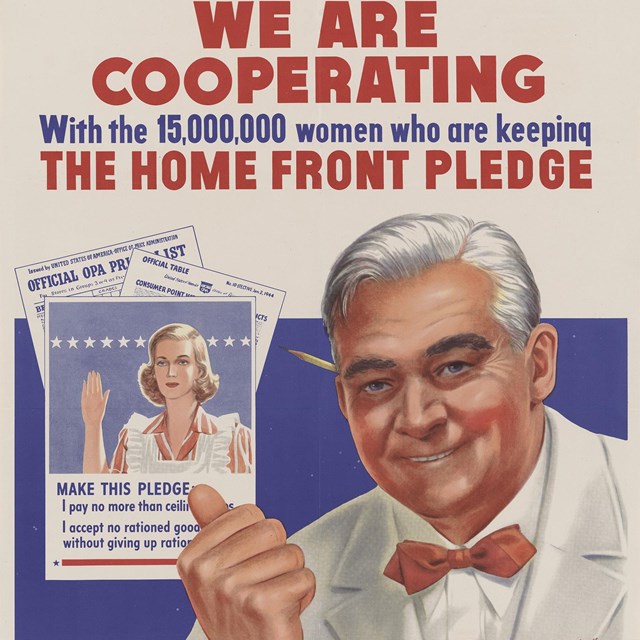 The Home Front During World War IIRestrictions and Rationing
The Home Front During World War IIRestrictions and RationingWartime shortages meant people had to do without or make due. Nylons, canned dog food, and sugar were some of the goods in short supply.
-
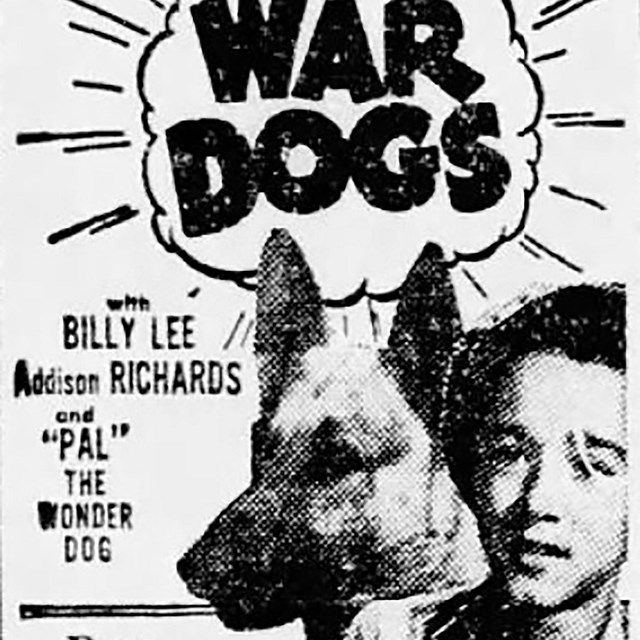 The Home Front During World War IIUncle Sam Needs to Borrow Your... Dog?
The Home Front During World War IIUncle Sam Needs to Borrow Your... Dog?Owners volunteered over 40,000 pet dogs for World War II service, spurred in part by the 1942 War Dogs movie.
-
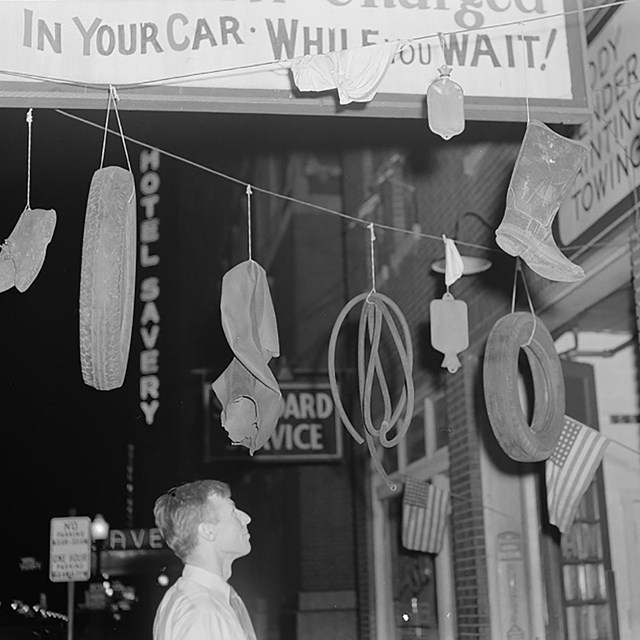 The Home Front During World War IIMaterial Drives
The Home Front During World War IIMaterial DrivesCelebrities including Mickey Mouse and Bing Crosby urged Americans to “Salvage for Victory” and “Get In The Scrap.”
Tags
- world war 2
- world war ii
- wwii
- developing the american economy
- shaping the political landscape
- science and technology
- home front
- wwii home front
- world war ii home front
- industry
- transportation history
- industrial history
- labor history
- clothing
- business history
- military history
- asian american and pacific islander history
- fashion history
- mining history
- economic history
- wilmington
- north carolina
- american world war ii heritage city program
- awwiihc
- government history
- african american history
- wwii aah
- washington dc
- manitowoc
- wisconsin
- pittsburgh
- pennsylvania
- dayton
- ohio
- arkansas
- manzanar
- california
